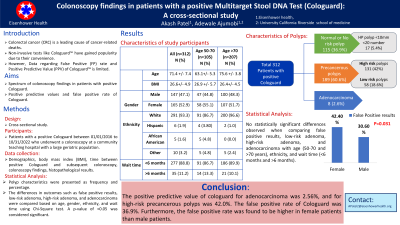Tuesday Poster Session
Category: Colorectal Cancer Prevention
P3176 - Colonoscopy Findings in Patients With a Positive Multitarget Stool DNA Test: A Cross-Sectional Study
Tuesday, October 24, 2023
10:30 AM - 4:00 PM PT
Location: Exhibit Hall

Has Audio
- AP
Akash Patel, MD
Eisenhower Health
Rancho Mirage, CA
Presenting Author(s)
Akash Patel, MD1, Adewale Ajumobi, MD, MBA, FACG2
1Eisenhower Health, Rancho Mirage, CA; 2Eisenhower Health, University of California, Rancho Mirage, CA
Introduction: Colorectal cancer (CRC) is a leading cause of cancer deaths world-wide. Non-invasive multitarget stool DNA (Cologuard) test has gained popularity as a convenient alternative to colonoscopy. However, limited research exists on colonoscopy findings in patients with positive Cologuard results, false positive rate and positive predictive value (PPV). Our study aims to assess Cologuard's false positive rate and PPV.
Methods: A cross-sectional study was conducted on patients with positive Cologuard results between January 1, 2016 and October 31, 2022 at a large community teaching hospital. Data was collected on patient demographics, body mass index (BMI), time between positive Cologuard and colonoscopy, colonoscopy findings, and histopathological results. Polyp characteristics were presented as frequency and percentage. The differences in outcomes were compared using Chi-Square test. A p-value < 0.05 was considered significant.
Results: The study included 312 patients with a mean age of 71.4 ± 7.4 years. The majority of patients were over 70 years old (66.4%), female (52.9%), and non-Hispanic white (93.3%), with a mean BMI of 26.6 ± 5.0. The majority of patients (88.8%) underwent colonoscopy within 6 months of receiving positive Cologuard results. Of the 312 patients, 8 (2.6%) had invasive adenocarcinoma, and 189 patients (60.6%) had any precancerous polyps, such as tubular adenoma (TA) or sessile serrated adenomas (SSAs). Among these patients, 131 (42.0%) had high-risk precancerous polyps, such as SSAs, >3 TAs adenomas, or polyps with a size >10mm, and 58 (18.6%) had low-risk adenoma, such as 1-2 TA with a size < 10mm. Of the remaining patients, 115 (36.9%) had a normal colonoscopy or no precancerous polyps, and among that 17 (5.4%) had hyperplastic polyps with a size < 10mm and < 20 in number. There were no statistically significant differences observed when comparing false positive results, low-risk adenoma, high-risk adenoma, and adenocarcinoma with age (50-70 and >70 years), ethnicity, and wait time (< 6 months and >6 months). However, there was a significantly higher false positive rate in female patients compared to male patients (42.4% vs. 30.6%, p=0.031).
Discussion: The positive predictive value (PPV) of cologuard for adenocarcinoma was 2.56%, and for high-risk precancerous polyps was 42.0%. The false positive rate of Cologuard was 36.9%. Furthermore, the false positive rate was found to be higher in female patients than male patients.
Disclosures:
Akash Patel, MD1, Adewale Ajumobi, MD, MBA, FACG2. P3176 - Colonoscopy Findings in Patients With a Positive Multitarget Stool DNA Test: A Cross-Sectional Study, ACG 2023 Annual Scientific Meeting Abstracts. Vancouver, BC, Canada: American College of Gastroenterology.
1Eisenhower Health, Rancho Mirage, CA; 2Eisenhower Health, University of California, Rancho Mirage, CA
Introduction: Colorectal cancer (CRC) is a leading cause of cancer deaths world-wide. Non-invasive multitarget stool DNA (Cologuard) test has gained popularity as a convenient alternative to colonoscopy. However, limited research exists on colonoscopy findings in patients with positive Cologuard results, false positive rate and positive predictive value (PPV). Our study aims to assess Cologuard's false positive rate and PPV.
Methods: A cross-sectional study was conducted on patients with positive Cologuard results between January 1, 2016 and October 31, 2022 at a large community teaching hospital. Data was collected on patient demographics, body mass index (BMI), time between positive Cologuard and colonoscopy, colonoscopy findings, and histopathological results. Polyp characteristics were presented as frequency and percentage. The differences in outcomes were compared using Chi-Square test. A p-value < 0.05 was considered significant.
Results: The study included 312 patients with a mean age of 71.4 ± 7.4 years. The majority of patients were over 70 years old (66.4%), female (52.9%), and non-Hispanic white (93.3%), with a mean BMI of 26.6 ± 5.0. The majority of patients (88.8%) underwent colonoscopy within 6 months of receiving positive Cologuard results. Of the 312 patients, 8 (2.6%) had invasive adenocarcinoma, and 189 patients (60.6%) had any precancerous polyps, such as tubular adenoma (TA) or sessile serrated adenomas (SSAs). Among these patients, 131 (42.0%) had high-risk precancerous polyps, such as SSAs, >3 TAs adenomas, or polyps with a size >10mm, and 58 (18.6%) had low-risk adenoma, such as 1-2 TA with a size < 10mm. Of the remaining patients, 115 (36.9%) had a normal colonoscopy or no precancerous polyps, and among that 17 (5.4%) had hyperplastic polyps with a size < 10mm and < 20 in number. There were no statistically significant differences observed when comparing false positive results, low-risk adenoma, high-risk adenoma, and adenocarcinoma with age (50-70 and >70 years), ethnicity, and wait time (< 6 months and >6 months). However, there was a significantly higher false positive rate in female patients compared to male patients (42.4% vs. 30.6%, p=0.031).
Discussion: The positive predictive value (PPV) of cologuard for adenocarcinoma was 2.56%, and for high-risk precancerous polyps was 42.0%. The false positive rate of Cologuard was 36.9%. Furthermore, the false positive rate was found to be higher in female patients than male patients.
Disclosures:
Akash Patel indicated no relevant financial relationships.
Adewale Ajumobi indicated no relevant financial relationships.
Akash Patel, MD1, Adewale Ajumobi, MD, MBA, FACG2. P3176 - Colonoscopy Findings in Patients With a Positive Multitarget Stool DNA Test: A Cross-Sectional Study, ACG 2023 Annual Scientific Meeting Abstracts. Vancouver, BC, Canada: American College of Gastroenterology.
